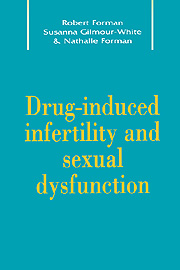4 - Cancer chemotherapy
Published online by Cambridge University Press: 30 March 2010
Summary
Factors influencing reproductive toxicity
Chemotherapeutic agents can have significant toxic effects on the gonads and these cause major degrees of reproductive dysfunction. In the early days of cancer chemotherapy, reproductive toxicity was a secondary consideration to attempting to cure the disease. Fertility only became a concern when cancer treatment was associated with disease remission and patient survival. Now that some cancers are 100% curable, future reproductive capacity is of major importance to patients, particularly young men and women. Patients may only agree to chemotherapy that does not harm their ability to become parents.
Early cancer chemotherapy usually consisted of the administration of a single drug, and identification of the agent responsible for reproductive toxicity was obvious. Significant information is available from early studies and follow-up data are now available to assess the possibility of long-term recovery of reproductive function following treatment. More recent trends in cancer chemotherapy are towards combinations of several cytotoxic drugs with different mechanisms of action. The aim is to maximise cytotoxic activity while reducing toxicity to healthy tissues. Consequently, it is often less apparent which of the drugs used is responsible for the toxic effect.
In general, cytotoxic drugs exert the most marked effect on rapidly dividing tissue, and germ cells are particularly sensitive. The reproductive consequence of the treatment depends not only on the dose administered but also the sex of the patient and the stage in reproductive life. The neoplastic process itself may also adversely affect sexual function.
This chapter will review the mechanisms of action of cytotoxic therapy and describe known associated reproductive toxicity.
- Type
- Chapter
- Information
- Drug-Induced Infertility and Sexual Dysfunction , pp. 52 - 71Publisher: Cambridge University PressPrint publication year: 1996



